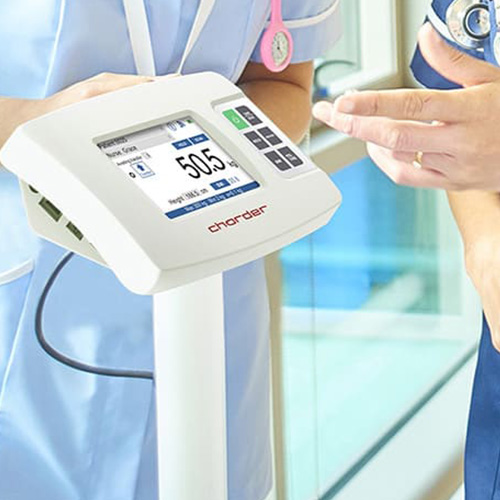Research Regarding Sarcopenia

Assessment of muscle mass and strength for diagnosis of sarcopenia is a more and more frequent need in societies with rapidly growing elderly populations. In other articles, we've highlighted best practices and how to use Grip Strength Dynamometers and Body Composition Analyzers as part of well-established sarcopenia assessment protocol.
There is a significant amount of scientific research regarding this topic, and it can be hard to get into at first! We've highlighted several of the most useful and easy-to-understand papers for reference:
Higher Phase Angle is indicative of better strength and aerobic fitness
Parameters: Phase Angle
Published: 2022
Journal: Nutrition
Summary: A systemic review of 34 studies exploring the relationship between (1) Phase Angle and muscle strength, and (2) Phase Angle and aerobic fitness was conducted.
Higher Phase Angle was associated with higher muscle strength and better aerobic fitness - for different age groups and health conditions - in a vast majority of the studies (only 2 of 34 did not find a direct relationship).
Why this is useful: Charder's professional body composition analyzers utilize muscle mass, age, phase angle, and other variables to estimate grip strength. This paper helps demonstrate that higher phase angle does indeed correlate with higher strength, explaining why Charder is able to provide such results with improved accuracy.
BIA-assessed sarcopenia has prognostic value
Parameters: Muscle
Published: 2019
Journal: The Oncologist
Summary: Sarcopenia is prognostic for numerous health outcome, but it is rarely assessed in routine clinical practice because it is traditionally difficult and time-consuming to diagnose and track. BIA is more portable, easy-to-use, and convenient compared to imaging "gold standard" alternatives, but can BIA-based muscle measurements detect sarcopenia reliably?
A systemic review of 24 studies regarding the use of BIA in detection of sarcopenia in adults with cancer was conducted, with the conclusion that BIA has prognostic value for evaluating low muscle mass for diagnosis of sarcopenia. Importantly, two of the studies showed that BIA was comparable to gold standards (CT, MRI), indicating that it is a feasible replacement method.
Why this is useful: BIA is a fast, safe, and convenient method for muscle measurement. However, there are sometimes concerns about accuracy, and whether or not results are reliable enough to be used for diagnosis in medical settings. This systematic review of multiple studies helps prove that in real-world settings, BIA can indeed be used for such purposes.
Elderly adults lose strength faster than they lose muscle
Parameters: Muscle
Published: 2006
Journal: Journal of Gerontology
Summary: It is common for people to lose muscle and strength as they age. A 3-year study was conducted, measuring both muscle and strength.
Decline in strength after 3 years was much more rapid than decline in muscle mass. As such, although measurement of muscle is important, assessment of strength is also needed for early detection of sarcopenia.
Why this is useful: Charder's unique "Muscle Quality" result provides an estimate of grip strength. Why is this necessary, when all other BIA devices only provide muscle quantity? This paper helps explain that because muscle strength declines more rapidly than muscle mass, relying solely on mass can result in sarcopenia being overlooked. Therefore, an estimate of muscle strength may be quite valuable for advance warning signs of potential sarcopenia.
European consensus on best methods for identifying sarcopenia
Parameters: Muscle, Strength
Published: 2018
Journal: Age and Ageing
Summary: A standardized measurement protocol has been proposed and updated in acccordance with updated scientific evidence, in order to screen and diagnose sarcopenia using various methods.
- Low muscle strength is defined as grip strength < 27 kg for men and < 16 kg for women using dynamometer
- Low muscle mass is defined as Appendicular Skeletal Muscle Index (ASMI) <7.0 kg/m2 for men and <5.5 kg/m2 for women using BIA
(Other assessment methods are also included in full study.)
Why this is useful: Different regions may have different standards for defining "low" or "normal". This paper outlines the common European standards for grip strength and muscle mass using BIA - patient's results can be compared to these cut-off points to help evaluate sarcopenia.
Asian consensus on best methods for identifying sarcopenia
Title: Asian Working Group for Sarcopenia: 2019 Consensus Update on Sarcopenia Diagnosis and Treatment
Parameters: Muscle, Strength
Published: 2020
Journal: JAMDA
Summary: A standardized measurement protocol has been proposed and updated in acccordance with updated scientific evidence, in order to screen and diagnose sarcopenia using various methods.
- Low muscle strength is defined as grip strength <28 kg for men and <18 kg for women using dynamometer
- Low muscle mass is defined as Appendicular Skeletal Muscle Index (ASMI) <7.0 kg/m2 for men and <5.7 kg/m2 for women using BIA
(Other assessment methods are also included in full study.)
Why this is useful: Different regions may have different standards for defining "low" or "normal". This paper outlines the common (East) Asian standards for grip strength and muscle mass using BIA - patient's results can be compared to these cut-off points to help evaluate sarcopenia.
Please feel free to contact us if you have any questions!




